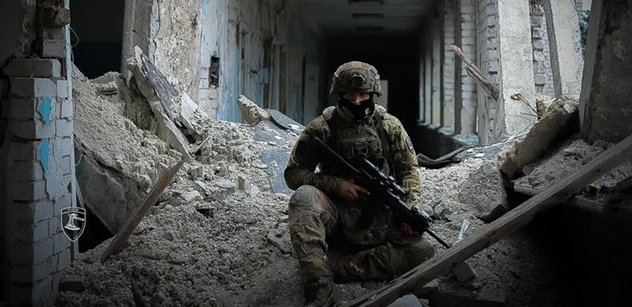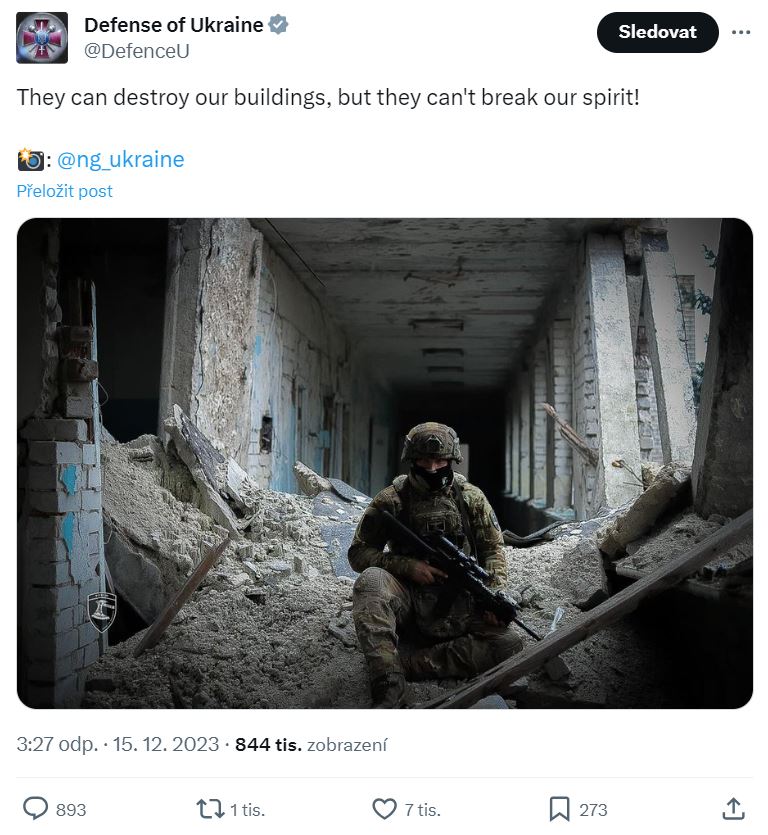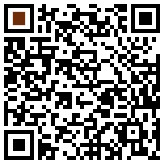Ukrainian forces face considerable scandal on social networks due to accusations of promoting Nazi symbols. Angry reactions were sparked by Ukraine’s Defense Ministry, which shared a photo of one of the Ukrainian soldiers in uniform with an imperial eagle-like symbol attached to it. Although it is not known what the patch contains, due to its similarity to Nazi symbolism, it causes considerable embarrassment, and many point to past incidents of unmistakable and genuine neo-Nazi symbols. Ukrainian army. Although symbols associated with Nazism are banned in the country.

Repro X
Description: A photo of a Ukrainian soldier with a suspicious connection
Questionnaire
Do you consider Tomáš Halík a moral authority?
Voted by: 20633 people
Ukrainian forces have received accusations of neo-Nazism on social media due to a post by the Ukrainian Defense Ministry that shared a photo of a soldier in Ukraine’s National Guard sitting with a gun in his hand. and a vestment bearing a striking resemblance to the Imperial eagle.
“They can destroy our buildings, but they can’t break our spirit!” The account of the Ukrainian Ministry of Defense on the X social network captioned the photo, prompting an avalanche of comments from people who did not understand why Ukrainians were circulating an image. A member’s with Nazi embroidery.
From the photo, it is not clear that the soldier had a Reich Nazi eagle on his uniform, because it was supplemented with a swastika and often used as an aquila – a Roman symbol. Legions, but many have it because the Nazis are only associated with this infamous episode of modern history. Also, the enlarged image doesn’t come close to revealing what’s really there.

Photo Gallery: – Soldiers training in Ukraine
It was pointed out by many commentators that it was a Roman eagle attached to a Ukrainian trident, many pointing out in the discussion under the posts of people who were highly critical, believing that the Ukrainian ministry was circulating a photo of a soldier with Nazi symbols. He pointed out that such a link can usually be bought on the Internet and does not contain a swastika – As many argued – But the national symbol of Ukraine appeared thousands of years ago on the territory of Ukraine.
The association of the Ukrainian national emblem with the Roman eagle is controversial for many, although it is not a symbol that originated directly during the Nazi occupation. Some commentators pointed out that “they appropriated a symbol that had nothing to do with Ukrainian history except the Nazi occupation.”

“The ‘Roman eagle’ is the same ‘Roman eagle’ worn by the Nazis. Only the ‘Roman salute’ is missing. Not really, there are plenty of videos of Ukrainians doing the Roman salute as well,” wrote another contributor, referring to Ukraine’s troubled past and the fact that some Ukrainians collaborated with the Nazis during World War II. Added a photo to make it clear.

Photo Gallery: – Independence Day of Ukraine
Ukraine has been trying to come to grips with this difficult past — and the symbols that represent it — in recent years, but even so, especially during the current conflict, there are occasions when neo-Nazi symbols appear on Ukrainian teams. Although the forces, and Ukrainian authorities, have made it clear that this is about the misconduct of individuals, it does not add up to the media image of the stricken country, especially at a time when Russian propaganda often accuses it of Nazism.
There have been many similar incidents, for example, the incident from May this year caused great outrage, when Czech television broadcast footage of a Dana howitzer with a beam cross drawn, which was used by the German Wehrmacht. Reuters also published similar footage of a Czech self-propelled howitzer.
At the same time, this is not an entirely isolated case. Crosses of the Wehrmacht have repeatedly appeared on Ukrainian equipment, and a few months ago, a photographer from the Reuters agency caught markings on training tanks near the Belarusian border, which again clearly refer to beam crosses. Even Ukrainians do not deny the presence of additional markings on the tanks with the shadows of beam crosses used by the great German Empire at the end of World War II. According to Novinky.cz server, who received a statement from the Ukrainian Embassy, which indicated that the incident was being investigated and that “a soldier who did it without the approval of the leadership” had been painted with crosses. Once discovered, the emblems were removed from the vehicles.
Photo gallery: – Concert for Ukraine
In 2014, footage of the German ZDF documenting Nazi symbols, including swastikas, on the helmets of members of the Ukrainian army’s volunteer corps also sparked outrage, and recently, similar symbols continue to appear on the uniforms of some Ukrainian soldiers. NFootage from Anadolu Agency and Reuters last year For example, members of the Ukrainian civilian counter-intelligence SBU can be seen with the inscriptions “SS Galizien”, a reference to the infamous breakaway from the structures of Hitler’s Germany.
Also known as the 14th Volunteer Division “Halik” or SS Galicia, this unit was ironically credited with murdering not only Poles and Jews, but also Ukrainians, and was used to quell the Slovak National Uprising. Six war crimes include burning villages or mass executions of prisoners of war.
Jaroslav Hanka, a 98-year-old Ukrainian World War II veteran, received a standing ovation from Canadian Parliament, including Canadian Prime Minister Justin Trudeau, during a visit by Ukrainian President Volodymyr Zelensky. In September, it caused an international outcry and the resignation of Canadian Parliament Speaker Anthony Rota, who invited Hanka to a speech by Zelensky.
Photo gallery: – Russia is a terrorist country
For Ukraine, such incidents are very harmful, the country has been trying to confront them in recent years and not so much recall the bitter past associated with the Nazi collaboration of a part of Ukrainians, on the contrary, it actually attracts attention. A large number of Ukrainians died in World War II, mainly in the struggle against the Nazis during the liberation of Europe. In 2015, Ukraine passed a law condemning communist and Nazi regimes, denying the criminal nature of these regimes and using their symbols in public.
Ukraine (War in Ukraine)
Reports from the battlefield are difficult to verify in real time from whichever side of the conflict. Both the warring parties may, for understandable reasons, publish false (false) information in whole or in part.
PL editorial content discussing this conflict can be found on this page.
War in Ukraine
Reports from the battlefield are difficult to verify in real time from whichever side of the conflict. Both the warring parties may, for understandable reasons, publish false (false) information in whole or in part.
CTK updates brief information related to this conflict several times an hour On this page. PL editorial content discussing this conflict can be found on this page.
Author: Radek Kodas
Fact check Beta
A factual error in reporting? Help us fix it.
